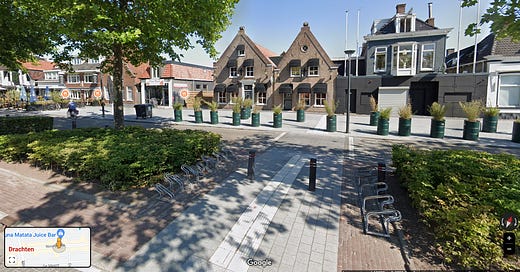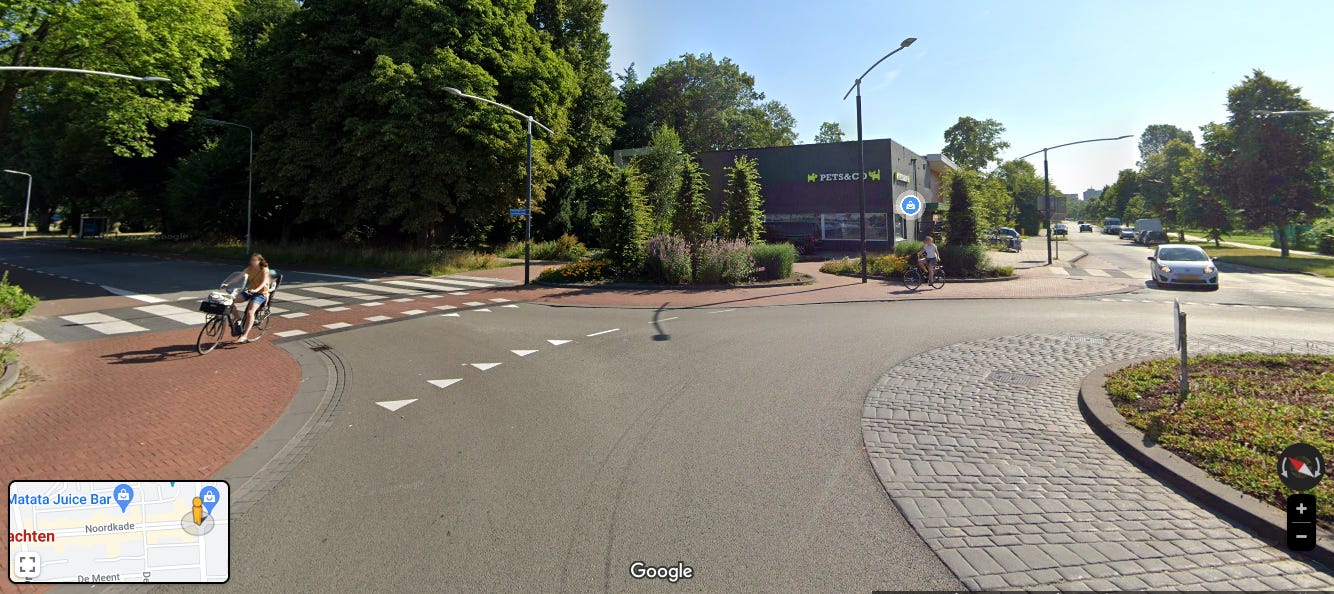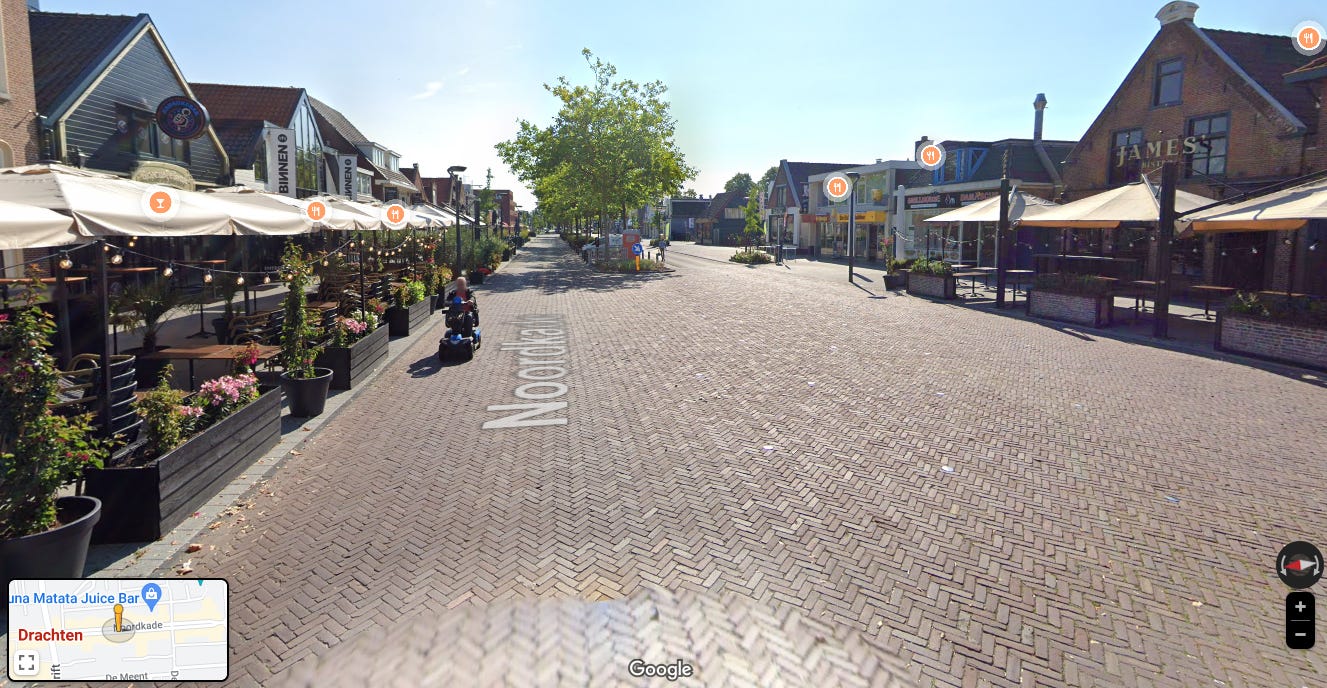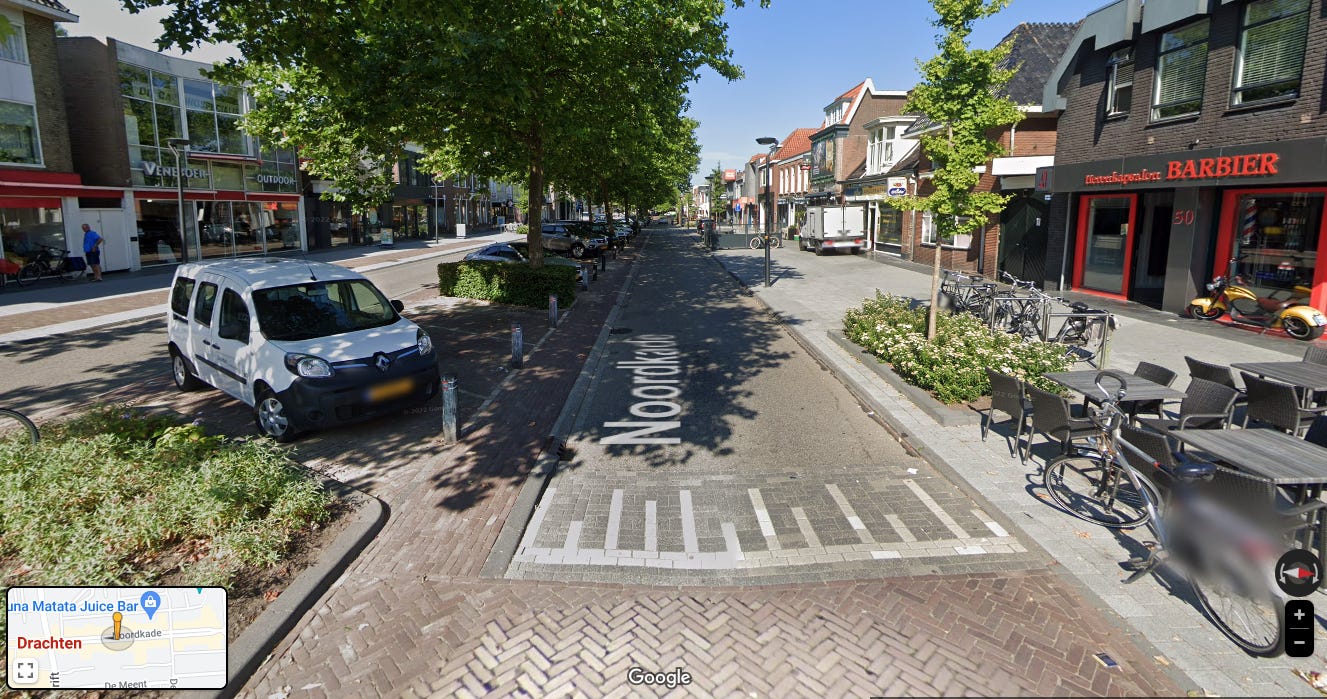Psychology of Shared Spaces
The Dutch propose a simple interpretation of "design is people" —naked streets.
When you’re in a shopping mall or Disney World, you aren’t worried about stepping out of your lane or swerving into oncoming traffic. Everyone’s a pedestrian. You might jockey for a better cashier line, but the stakes of unpredictable behavior are low. Imagine having the same mobility boldness in an environment that allowed scooters, bikes, large buses, delivery trucks, and passenger cars.
Shared spaces, or "naked streets,” are designed to be shared by everyone using every mode, without the traditional segregation of space. The psychology of shared space is grounded in the idea that humans have an innate ability to navigate and adapt to their environment, and that clear and consistent design cues can help guide behavior.
It means removing traffic signals, pavement markings, and road signs to encourage people to behave more responsibly and attentively, because they’re forced to rely on their own senses and judgment to navigate space.
I learned about shared spaces from Ben Hamilton-Baillee, a fun-loving urbanist who passed away four years ago. Congress for the New Urbanism was the matchmaker that helped me discover this kindred soul. It probably wouldn’t surprise you that my favorite memory of Ben is four of us new urbanists riding borrowed folding bikes on a “follow your intuition” tour of Buffalo. It ended on a stranger’s porch who invited us up for an impromptu happy hour, turning strangers into friends.
I take you on that brief tangent, because that’s the outcome of good urbanism. Human interactions that aren’t dependent on personal cars or taxis. I don’t see much coverage of shared spaces in the US, probably because of the intense shock factor: “What? A stripped down street, are you out of your mind?!” I’ll admit, it’s not easy to grok for an American context. But the philosophy that drives it is human-scale design, so I think it’s worth exploring.
Those Dutch designers
The Dutch approach to shared space design is grounded in a philosophy of "self-explaining roads," which means that the design of the road itself should communicate to users how it is intended to be used. Design elements could be changes in road surface materials or textures, narrowing or widening of the road, street furniture, public art, and whatever else you might think of.
The goal is to create a place that’s so well designed that people automatically adjust their behavior to fit the space, regardless of how they’re moving (foot, bike, scooter, car). It’s a great example of applying psychology to public infrastructure.
Hans Monderman was a Dutch traffic engineer and road safety specialist who is considered one of the most significant influences on the current debate about the design of streets and spaces in the UK. Monderman's approach to street design inspired a long list of towns and villages across the UK which work without road markings, traffic signs, signals, curbs, barriers and bollards. He thought separating people and vehicles created a false sense of security and encouraged dangerous driving behavior.
Monderman's philosophy was simple: to slow down traffic, create an environment where drivers feel uncertain about what’s expected of them.
He argued that drivers would be forced to pay closer attention to their surroundings, take greater care, and slow down.
When I first heard this, it made obvious sense, because I imagined myself lost. Yes, I’d slow down and look for cues. But would it, could it, should it be applied to urban design? I had no idea.
In shared spaces, pedestrians, cyclists, and motorists share the road. I wouldn’t say they’re equals, because calm traffic naturally favors the pedestrians. Shared space is extreme traffic calming, intended to create a sense of community.. It’s a physical manifestation of concepts like “places for people” and “human-scale design.”
One of the most striking examples of Monderman's shared spaces is the Dutch town of Drachten. It started with a major intersection converted into a shared space, yanking out the traffic lights, road markings, and a bunch of signs. The town tracked a significant drop in crashes after the changes were made, and the area has become a popular destination, rather than a place to just zip through in a car.
Monderman's approach to street design has been controversial, in part because critics can’t handle nuance. Social media lights up like “Oh, so you’re saying a blind person in a wheelchair should just fend for themselves? Got it.” But of all the approaches to street design, shared space seems to have the strongest embrace of all-ages-and-abilities.
Creating a sense of place
Great places have streets that are inviting and that encourage people to spend time in them. Shared spaces typically have attractive street furniture, art installations, and landscaping that make them visually appealing and welcoming when you’re outside of a vehicle. It’s not necessarily elaborate. Look back at those Google Street View photos.
Ben Hamilton-Baillee was a protégé of Monderman, and the creative force behind the Town of Poynton’s shared space transformation in the UK. In the Town’s words,
Poynton’s innovative Shared Space Scheme was completed in 2012. This award winning regeneration scheme removed traffic lights and changed the lay out for what was one of the busiest junctions in Cheshire. It regenerated the main shopping street, Park Lane, and reinstated Fountain Place as the historic centre of the Town.
At its heart, Shared Space is a design concept that gives equal priority to all high street users from pedestrians, to vehicles and cyclists. With its wide pavements, slow vehicle speeds and easy crossing, Poynton offers a friendly and vibrant atmosphere for all visitors.
Research has shown that creating shared spaces can have a positive impact on local economies. When streets are designed to be inviting to pedestrians and cyclists, people are more likely to shop and dine locally. Transport for London found that streets with high levels of pedestrian activity had 25% higher retail rental values than those with low levels of pedestrian activity.
According to the Project for Public Spaces, shared spaces that prioritize pedestrians and cyclists can lead to a 60% increase in foot traffic and a 20% increase in retail sales.
When drivers are forced to slow down, they’re more likely to notice local businesses. This can lead to increased foot traffic, which we all know is the best kind of business traffic.
Reducing vehicle speeds
Critics argue that shared spaces are confusing for drivers and that they prioritize aesthetics over function. I guess that depends on what you mean by “function” of a street. The evidence suggests that shared spaces can be a powerful tool for creating vibrant, livable neighborhoods.
Streets with shared spaces have lower crash rates than those without. Yes, I realize you can’t just copy/paste this idea to a 6-lane arterial in Anywhere, USA. But in areas where you want to have low-and-slow car traffic, this could be huge. For a refresher on the importance of calm traffic, read the 40-20 rule.
Exhibition Road in London, England is a popular destination for tourists and locals, and features a wide pedestrian zone with no curbs or barriers. Drivers are forced to slow down and pay more attention to their surroundings, creating a safer and more enjoyable environment for all users.
Removing visual clutter
Visual clutter on our streets can be overwhelming. From traffic lights to signs, road markings to painted arrows, it can be difficult for drivers to know where to look. I’ve read enough crash reports over the years to see my share of rear-end crashes due to a driver trying to read signs.
Shared spaces are designed to be simple and uncluttered. Instead of lots of signage and road markings, shared spaces often have just a few simple features to guide drivers, cyclists, and pedestrians. This simplicity encourages drivers to pay more attention to their surroundings and take more responsibility for their actions. Don’t underestimate the power of intuition. (Steve Jobs certainly didn’t.)
A study by the Dutch Ministry of Transport and Public Works found that removing traffic signs and signals led to an average crash reduction of 30%. The same study also found that drivers were more likely to pay attention and drive more slowly when there were fewer signs and signals to distract them.
Of course, reducing visual clutter doesn't mean removing all signage and road markings. It's about finding a balance between guidance and simplicity. Shared spaces often use subtle features like colored paving or raised crosswalks to signal where pedestrians can walk and where cars should slow down.
In some cases, removing visual clutter can also help create a more attractive and welcoming street environment. By minimizing the number of signs and signals, shared spaces can help create a more cohesive and visually appealing space. This can be particularly important in urban areas where space is at a premium and every inch counts. (I’m looking at you, bike racks crammed against a wall.)
In shared spaces, streets are for people to gather, shop, and socialize. The focus is on creating an inviting and attractive space that encourages people to spend time in it.
Adopting this type of design philosophy is a challenge, no doubt. But we’ve seen an uptick in DOTs accepting Dutch designs for intersections and bicycle infrastructure, so who knows. There will always be environments where it makes sense to separate transportation by speed. But maybe we shouldn’t be so quick to dismiss a radical notion like naked streets, stripping away curbs and signs and markings and other crummy car-oriented accessories.










